
There are many ways to live life. One approach is to be positive, follow your principles and work towards your picture of success. This is an approach followed by many people, teams and organisations.
Different people follow these themes in different ways. Let’s explore how some people translate these into action.
Positive
People who take this approach are often positive realists. They have a positive attitude but are also good at reading reality. Bearing this in mind, they often choose:
To be positive rather than negative … To be creators rather than complainers … To take responsibility rather than avoid responsibility … To help people rather than hurt people.
They aim to build on their strengths rather than their shortcomings. They focus on what they can control rather than what they can’t control. They aim to do their best during their time on the planet.
They are good at seeing patterns in the areas where they excel. They then aim: a) to build on the successful patterns; b) to stop the unsuccessful patterns; c) to follow the strategies most likely to achieve success.
Positive realists are good at seeing possibilities. They have a history of studying success and clarifying what works in certain situations. Bearing this in mind, they often enjoy finding creative solutions to problems.
Such people are good at positive reframing. They reframe situations to focus on: a) the positive possibilities; b) the possible ways forward; c) the practical things they can to do achieve their picture of success.
Some people take this approach even when facing daunting challenges. Let’s look at two people who took these steps.
Alice Herz-Sommer – Choosing
To Have A Positive Attitude
Alice Herz-Sommer was somebody who chose to have a positive attitude to life. A pianist and survivor of Nazi concentration camps, she continued to be optimistic well past the age of 100.
Her view of life reached a wider audience after an interview she gave to the BBC became popular on the web. “Life is beautiful,” said Alice, and explained this in the following way.
“I have lived through many wars and have lost everything many times – including my husband, my mother and my beloved son.”
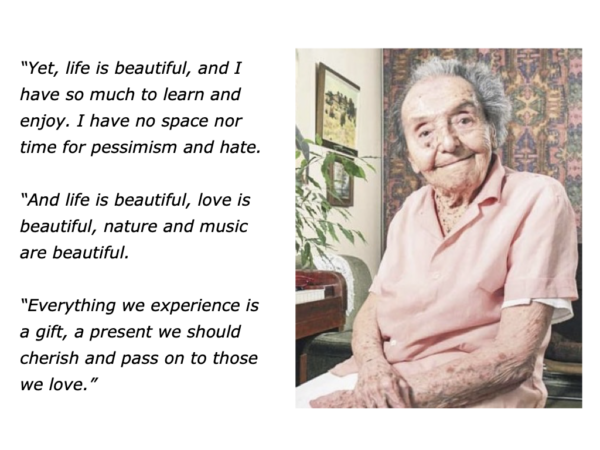
Life brings pain and beauty, said Alice, but she believed the secret of happiness was to focus on what is really important. She focused on gratitude, kindness, nature, music and the joyful things in life.
Caroline Stoessinger gave an insight to Alice’s approach in her book A Century of Wisdom: Lessons from the Life of Alice Herz-Sommer. She provided a series of quotes in which Alice explained her philosophy. These included the following.
“Gratitude is essential for happiness … Only when we are old do we realise the beauty of life … Music is a dream … It takes you to paradise … I am richer than the world’s richest people, because I am a musician … Music saved my life … Music is God.
“Every day is a miracle. No matter how bad my circumstances, I have the freedom to choose my attitude to life, even to find joy. Evil is not new. It is up to us how we deal with both good and bad. No one can take this power away from us.
“My optimism has helped me through my darkest days. It helps me now … The more I read, think and speak with people, the more I realise just how happy I am … When I die I can have a good feeling … I have done my best … I believe I lived my life the right way.”
People who take this approach do what they enjoy because this gives them strength to give to others. Alice did this through playing music and reflecting on the beautiful things in life.
Robert Muller – Reframing
Challenging Situations
Robert Muller, an Assistant General Secretary of the United Nations, was somebody who took these steps. He reframed challenging situations as a chance to find creative solutions. Here is a summary of his approach.
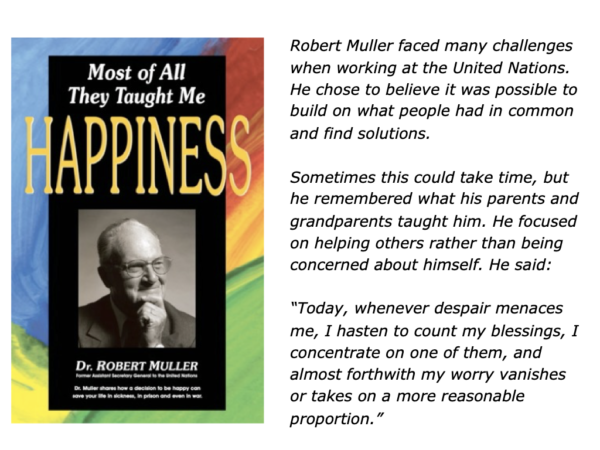
Robert focused on the opportunities in many challenging situations. He adopted this approach as a student when he was hunted by the Nazis during the Second World War.
One day he found himself trapped in an attic on the top floor of an hotel that also served as an office building. Several Nazis entered the reception area and asked people where they could find Robert. How could he escape the hunters?
Drawing on his positive attitude to life, Robert began thinking of creative solutions. He explained his approach in the following way.
“I was a great fan of Hollywood films, so I decided to see the situation as taking part in a film. I was being hunted, so how could I find a way to escape?”
David Gillies takes up the story in his biography about Robert called The Hatmaker’s Son. Here are excerpts from David’s book.
Robert took several deep breaths.
“I must overcome my fear and think rationally,” he decided. This was the moment of moments to be creative.
“What an opportunity, what a tremendous adventure – a 20-year- old student trapped by Nazis in a fancy hotel. Won’t it be great if I slip through their fingers?”
Robert took a few minutes to consider his options. The Nazis had some idea what he looked like but they probably had an old photo. How could he take on a different persona?
The hunters were also expecting to find a cowering student trying to hide in the milling crowds on each floor of the building. How could he be ingenious and do what the Nazis least expected?
Robert settled on his plan and began translating it into action. This involved making his way down four floors from the attic and walking out onto the street.
Putting a thick file under his arm, he exuded an air of authority as he made his way from floor to floor. Nonchalantly smoking a cigarette, he passed various groups of people.
Reaching the ground floor he approached a group of Nazis who were quizzing the receptionist. She chose not to recognise him, even though she was being threatened.
Robert went up to the Nazis and asked what was happening. They replied they were looking for Louis Parizot (the name by which Robert was known in the building).
He responded by saying he had seen Parizot on the top floor. Just like in a film, the Nazis rushed up the stairs. Robert then made his way out onto the street and rode away on a bike.
Robert faced many challenges in life, but he tried to see things in perspective. During a time spent in prison he focused on how he could appreciate life and give to others.
Strongly influenced by his parents and grandparents, he aimed to help others and build a better world. He continued to apply this approach throughout his life.
Thankful for the love he had been given, Robert kept returning to this positive philosophy. Even in the darkest hours, he had a sense of gratitude. He then applied his skills to help people to build on what they had in common and find positive solutions.
Let’s return to your own life. Imagine that you want to continue to have a positive attitude in the future. How can you do this in your own way? If you wish, try completing the following sentence.
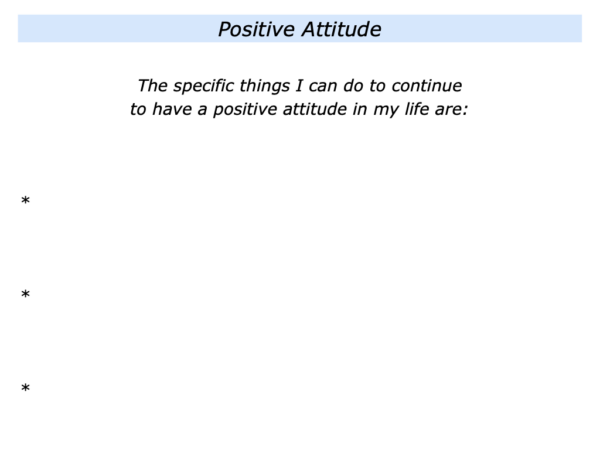
Principles
People who take the positive approach often follow their chosen principles and aim to translate these into action. Doing what they believe in gives them strength.
Such a person may follow certain moral principles, a spiritual faith or another belief system. They keep referring to this inner compass when making decisions in their daily lives.
What are the principles that you aim to follow in your life or work? Different people give different answers to this question. Here are some of the themes they mention.
My Principles – The principles
I try to follow in my life are:
To be grateful … To encourage people … To see every day as a bonus … To care for nature … To create beauty … To use my talents to help people … To do quality work … To give people positive memories for life.
Different people aim to follow their principles in different ways. Martin Seligman and Christopher Peterson focused on a related theme in their book Character Strengths and Virtues. Here is one definition of virtues:
Virtues are behaviours showing high moral standards. They are how we practice and demonstrate character. They are how we translate our values or principles into action.
Working with a team of researchers, they studied examples of positive traits and moral excellence that are admired across different philosophies, religions and cultures.
The researchers interviewed over 15,000 people in different cultures. After extensive research, the team settled on six key virtues – admired ways of behaving – though these are obviously interlinked. Martin explains their approach in the following way.
When we look we see that there are six virtues, which we find endorsed across cultures, and these break down into 24 strengths.
The six virtues that we find are non-arbitrary – first, a wisdom and knowledge cluster; second, a courage cluster; third, virtues like love and humanity; fourth, a justice cluster; fifth a temperance, moderation cluster; and sixth a spirituality, transcendence cluster.
We sent people up to northern Greenland, and down to the Masai, and are involved in a 70-nation study in which we look at the ubiquity of these.
Indeed, we’re beginning to have the view that those six virtues are just as much a part of human nature as walking on two feet are.
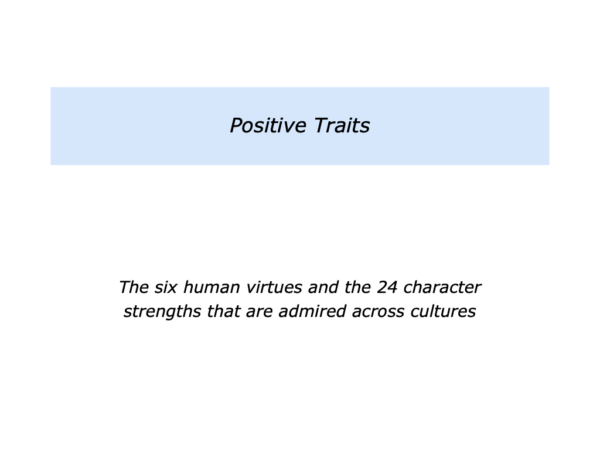
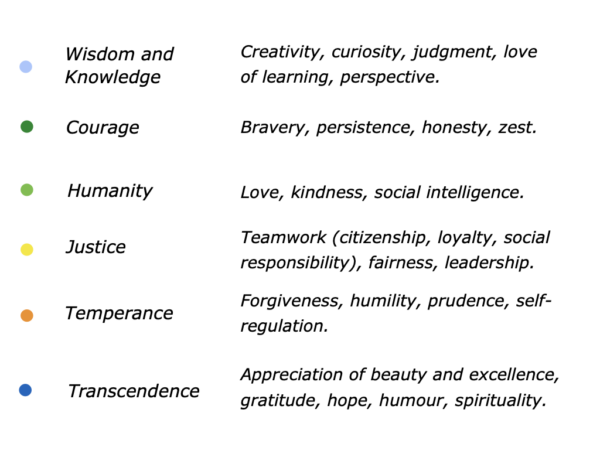
Let’s return to the question we asked earlier. What are the principles you want to follow in your life? How do you try to translate these into action?
What are the reasons why you want to follow these principles? What may be the benefits – both for yourself and other people?
If you wish, try tackling the exercise on this theme. This invites you to complete the following sentence.
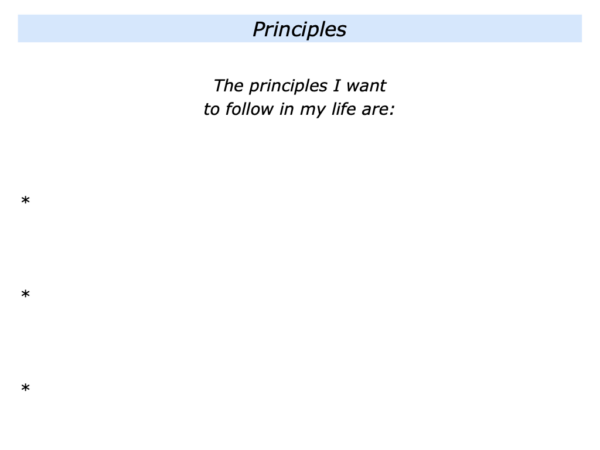
Picture Of Success
People who have a positive attitude often aim to follow their principles and express these by working towards a certain picture of success. Different people do this in different ways.
They may aim to encourage people in their daily lives. They may aim to build a happy family, help people to do satisfying work, provide medical care or do another activity that enables people to achieve their goals.
They may aim to build on their strengths and do superb work. They may aim to create an inspiring school, run a sports academy, lead a pioneering team or create a culture in which people can thrive.
They may aim to find solutions to challenges. They may aim to work as mediator, use technology to improve people’s lives or pass on knowledge that helps people to shape a positive future.
People who take this approach start by clarifying the real results they want to achieve. They then aim to build on their strengths, follow strategies that work and do their best to achieve their picture of success.
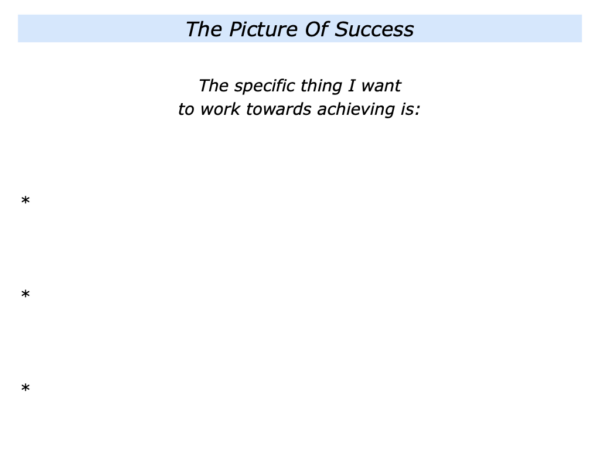
Different people follow elements of this approach in their own ways. Let’s look at one example.
Jo Berry, Patrick Magee and
Building Bridges For Peace
Jo Berry is dedicated to helping people to build on their common humanity. She created the organisation called Building Bridges For Peace. Later we will look at Patrick’s contribution to this remarkable work, but first here are Jo’s words.
On October 12th 1984 my father, Sir Anthony Berry and four others were killed in the bombing of the Grand Hotel, Brighton as they attended the Conservative Party Conference.
Two months later I randomly shared a taxi with a young Irish man whose brother had been in the IRA and had been killed by a British soldier.
We should have been enemies but instead we talked about a world where peace was possible and where there were no enemies. As I left the taxi, I had a flash of inspiration, this was one way I could make a difference, I could build a bridge across the divide.
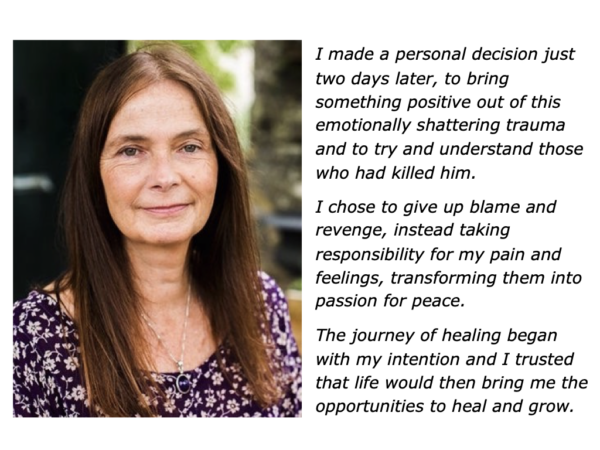
The hardest bridge to build was with Patrick Magee, who was sentenced for his part in planting the Brighton bomb and released as part of the Good Friday Peace Agreement in 1999.
I made enquiries from mutual friends and finally met Pat for the first time in November 2000 at a friend’s house in Dublin.
My intention was to hear his story so that I could experience him as a human being rather than a faceless enemy. I was scared and had doubts, but the strongest part of me needed to see him and speak to him.
I asked him many questions and shared a little about my Dad. At first he began to express his political perspective, which though I was familiar with was hard to hear but I could see he was a sensitive and intelligent person.
Then something changed. He stopped talking and said he didn’t know who he was any more, he wanted to hear my anger, my pain and what could he do to help.
It was as if he had taken off his political hat and had now opened up and became vulnerable. The conversation was very different after that and a new journey started, one which we are still on.
He now had a need to meet me and rediscover his lost humanity. When he planted the bomb he was not seeing human beings in the hotel, they were just a means to an end.
During our meetings, he began to develop the awareness that he had killed a human being with a soul, someone he could have sat down and had a cup of tea with.
He would later say that he was disarmed by the empathy I gave him, that he would have found it easier if I had met him shouting, blaming and defending my position. I wasn’t there to argue my point; I was there to listen and experience his humanity.
After three hours I could not talk anymore and ended our meeting by thanking him for his willingness to engage with me so honestly and he said he was sorry he had killed my Dad.
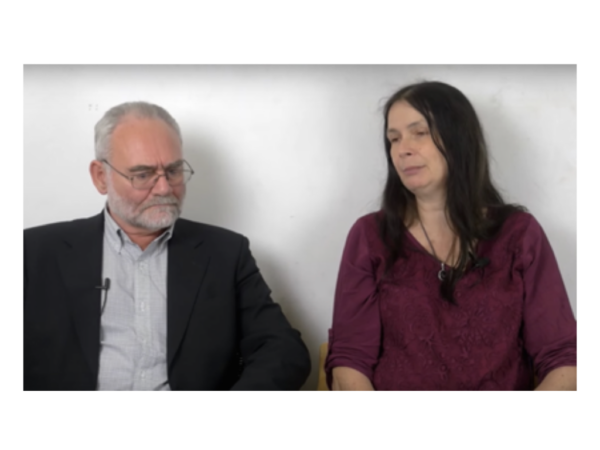
Patrick brings courage and humility to the process of building bridges for peace. Here is an extract from his story.
I was released from prison in 1999, having served 14 years under the terms of the Good Friday Agreement. Whilst in prison I completed a PhD examining the representation of Irish Republicans in ‘Troubles’ fiction.
It was important for me as part of the peace process in North of Ireland to recognise that now we should engage with former enemies and political opponents, addressing the needs and grievances of victims, helping to break down differences by explaining ourselves to the other.
For 27 years I was a committed member of the IRA, whether on active service, on the run or in prison. I spent a total of 17 years either interned or sentenced because of my involvement.
A crucial part of that legacy is the need to look back over the conflict and to understand it in terms of the many conflicting perspectives. That will entail ensuring that many voices previously excluded or misrepresented must now be heard, including the voices of the victims.
In that light, as an individual, I agreed to meet Jo. Her father, Sir Anthony Berry had been killed, along with four others, in the IRA’s attack on the Grand Hotel. I had planted the bomb.
So, on the day, I was there to explain, in essence to justify, the armed struggle; and specifically ‘Why Brighton’. I was wearing a political hat. We talked for three hours. But something happened during that first encounter.
Jo’s openness, calmness; her apparent lack of hostility – in fact her willingness to listen and to try to understand, disarmed me. Had Jo instead shown anger, however justifiable, it would for me have been easier to cope with.
The political hat would have remained firmly attached. But in the presence of such composure and decency, as I said, I felt disarmed. It was a cathartic moment.
It didn’t matter that as a former member of the IRA I could politically justify my past actions in terms of the legitimacy of the struggle.
As an individual I carried the heavy weight of knowing I had caused profound hurt to this woman. I expressed a need to really hear what she had to say and to help her come to terms with her loss, if that were possible:
‘I want to hear your anger, to hear your pain.’
A political obligation henceforth became a personal obligation. I now realised more fully that I was guilty of something I had attributed to the other: that our enemies demonised, dehumanised, marginalised, reduced us.
In agreeing to meet me that first occasion and in continuing to meet me she has demonstrated a truly admirable, strength and purpose in her endeavour to try to make sense of her loss and her preparedness to listen to my perspective.
No matter what we can achieve as two human beings meeting after a terrible event, the loss remains. Neither forgiveness nor understanding can fully embrace that loss.
The hope lies in the fact we continue to meet in order to further this mutual process towards understanding.
Let’s return again to Jo’s story and her words. Here is how she summarises some key themes in the work of Building Bridges For Peace.
I passionately believe that there is humanity in everyone, and every time we demonise the “other” we are delaying the onset of peace in this world.
Once we find our own humanity, and we see the humanity in the other, then we are going to want them to have their human rights, their good housing, food, medicine, education and freedom to be themselves, to be safe and secure.
We will want for them all what we want for ourselves. Peace happens when we treasure everyone, all creatures, our land, our planet, and work together to find solutions in which everyone wins.
Choosing To Work Towards
A Picture Of Success
There are many ways to live life. This piece has looked at how some people aim to be positive, follow their principles and work towards a picture of success.
Different people do this in different ways. Some people take the following steps.
They choose to have a positive attitude, focus on what they can control and clarify the real results they want to achieve. They translate these into a clear picture of success.
They clarify the principles they want to follow in the situation. They the clarify strategies they can follow to give themselves the greatest chance of achieving the picture of success.
They clarify their action plan, prepare properly and rehearse what they are going to do. They then aim to perform superb work, keep improving and do their best to achieve the picture of success.
Let’s return to your own life and work. Looking ahead, can you think of a situation where you may want to follow elements of this approach? This could be in your personal or professional life.
How can you continue to have a positive attitude? How can you follow your principles? How can you then do your best to achieve your picture of success? What may happen as a result of taking these steps?
If you wish, try tackling the exercise on this theme. This invites you to complete the following sentences.
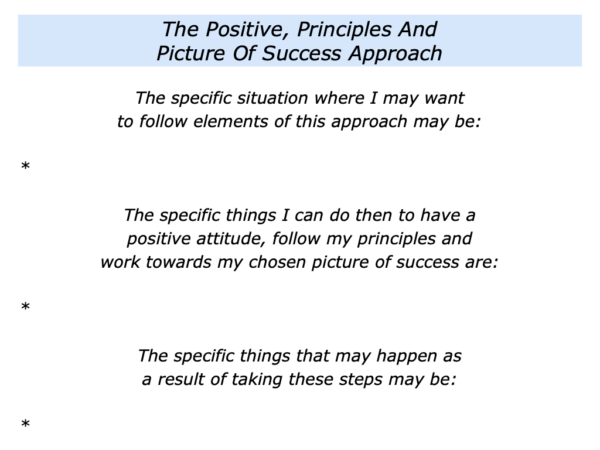






Leave a Reply